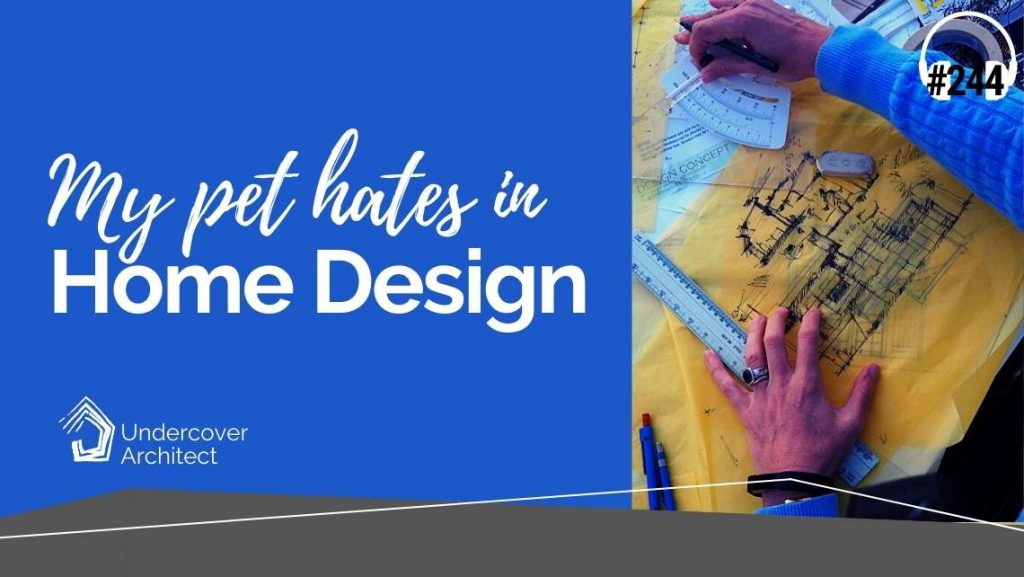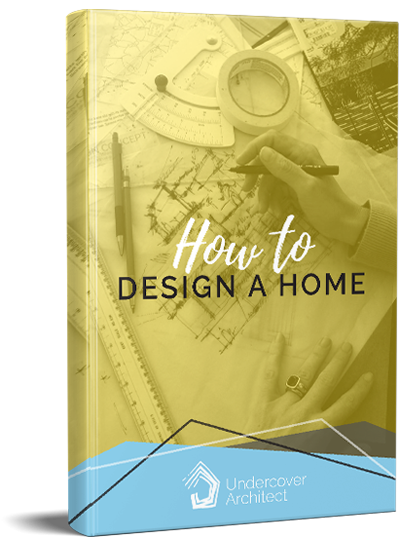
Learn more about some of the specific things to avoid when designing your future home.
Whether you’re building new or renovating an existing home, there are some home design ideas that simply don’t work.
Listen as I share some of my pet hates in home design.
Hello! This is episode 244, and in it, I’m going to share some home design ideas and choices I regularly see, that are actually pet hates of mine. Just because they really don’t work. I get pretty passionate about home designs that don’t work, hence calling these things ‘pet hates’!
This will be a chance to hear about some choices I see regularly made in home design that, in my experience, fall short when achieving functionality, or a good outcome for the home and its use.
With each, I’ll also make suggestions about what you can do as an alternative.
Now, let’s dive in!
As an architect, it’s hard to keep track of how many home floor plans I’ve designed. Because it’s not just the 250 plus homes that are built and finished. It’s all the options that have been worked on and presented along the way. It would easily be in the thousands and thousands.
These are floor plan designs that work, would make great homes, but for loads of different reasons, they were not the preferred option. And so, they were vetted either before they even got to the client, or vetted by the client in their journey of choosing their ideal and future home design.
And of course, as an architect, studying floor plan and home design is an occupational pastime. Whether it’s through collecting floor plan after floor plan that I see online in the free Facebook groups or on websites, or it’s in the in-person visits to homes.
I think most architects and designers will agree that it’s their usual experience to see them, and observe, assess what is working and what’s not. And even collect them along the way.
Now, before I dive into this episode, I want to be clear about something.
Whenever I’m reviewing floor plans, and determining what could be done to improve them, this is not a matter of taste or aesthetics.
For me, design is not about what something looks like, its colours, or even its materials and detailing. Those things are too subjective, and totally come down to personal preferences.
Equally, I do NOT see design as something that is high-end, or even necessarily award-winning. Because awards don’t reward the best design. I know of many designers who completely disagree with the notion that some architectural and design awards are based on, and don’t even enter – and they’re doing brilliant design work.
Great design is also, definitely not, the most expensive choice.
Design is just about how something works. About how a problem gets solved. Or avoided altogether.
That’s how I like to think about design, and especially when it comes to home design. The best home designs are solving the everyday problems in everyday life.
They’re making spaces, places and the things within them work better for us, as the users of those spaces, places and things.
In fact, the best design works so well, it is almost invisible.
It just gets out of our way, and streamlines whatever we’re doing so that it’s easier, more convenient, more fun, more enjoyable, more organised, more calm.
In fact, Seth Godin who is an amazing designer and marketer, said this:
“Design is about function. Everything we do has a job, and if it’s designed properly, the job will get done well. When we think about what might go wrong, we’re more likely to design something that goes right.”
Your home’s job is an important one.
Beyond the pragmatics of shelter, safety, comfort, there’s been loads of research done to highlight the impacts and importance of the quality of environment your home provides.
On our lifestyles, our well-being, our health, our anxiety and stress levels, and our ability to enjoy ourselves and feel fulfilled.
And given how much time we’re spending in our homes(especially over the past couple of years!), this impact has been magnified and felt more keenly by many.
I think many can understandably get caught up in the aesthetics of creating a home.
All the finishes, fixtures, materials and products we see when researching and considering what we want in our future home are often presented in a really glossy, Pinterest or Instagram worthy package. And then often, we equate that with the quality of the design outcome.
And it’s definitely not helped by the fact that we’re fed glossy image after glossy image of beautifully styled homes. It’s super rare for great design to be presented to us in a really ordinary package, because that doesn’t photograph well!
Unfortunately I’ve seen far too many homes that had terrible designs, but because they were styled incredibly well, it’s easy to be fooled that it’s a great home. The fact is that styling and staging won’t actually fix the functionality of a poorly designed home.
Want to know what some of my pet hates are in home design?
Listen to the episode now.
RESOURCES:
Episode 8, Season 9: Before and After >>> Listen here
Season 9 of the podcast: Keeping it Real >>> The Season Index is here
This image describes the issue I discuss in my first pet hate >>> Avoid doing this in your laundry
This can be another problem in hallway design >>> Avoid hospital corridor style hallways
Your front entry and designing it well >>> Season 2, Episode 12
Designing staircases (and why a home design needs to start with them) >>> Season 2, Episode 10
Designing for Difficult Sites: Designing for a Wide Site >>> Season 6, Episode 3
Learn about your flooring choices and options available other than laminate and hybrid! >>> Start with Season 11, Episode 3 and go from there (there’s a few episodes on flooring)
Access my free “Your Project Plan” online workshop and awesome bonuses now >>> https://undercoverarchitect.com/projectplan
Access the support and guidance you need to be confident and empowered when renovating and building your family home inside my flagship online program >>> https://undercoverarchitect.com/courses/the-home-method/


 With over 30 years industry experience, Amelia Lee founded Undercover Architect in 2014 as an award-winning online resource to help and teach you how to get it right when designing, building or renovating your home. You are the key to unlocking what’s possible for your home. Undercover Architect is your secret ally
With over 30 years industry experience, Amelia Lee founded Undercover Architect in 2014 as an award-winning online resource to help and teach you how to get it right when designing, building or renovating your home. You are the key to unlocking what’s possible for your home. Undercover Architect is your secret ally
Leave a Reply